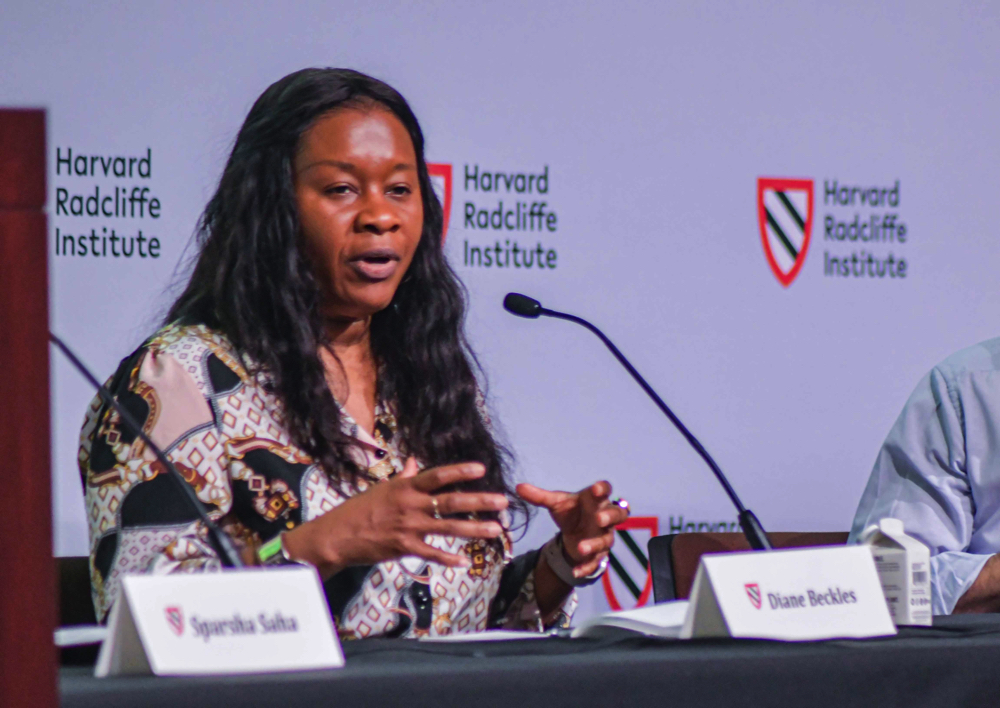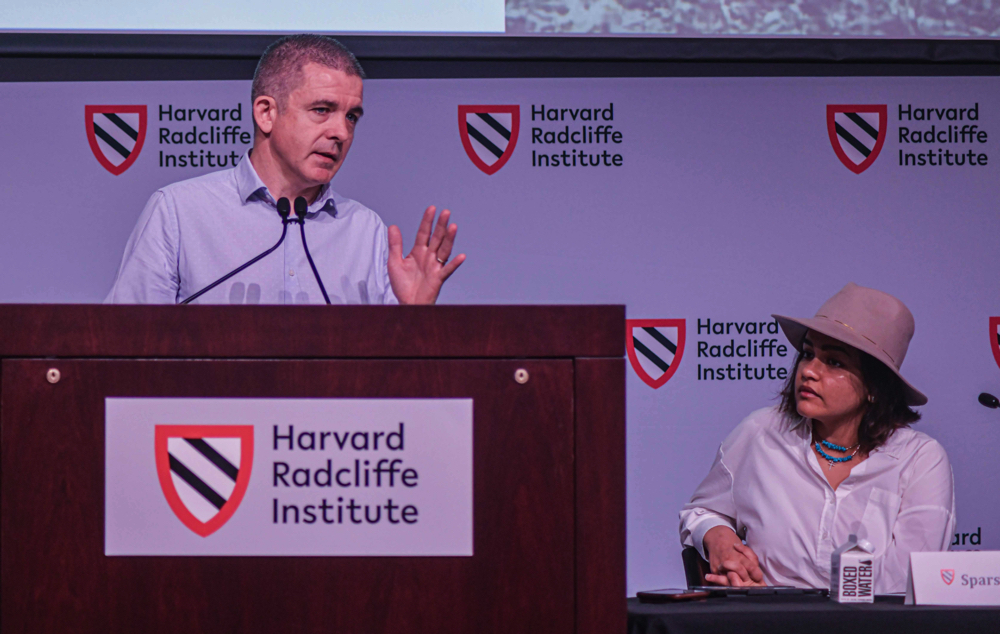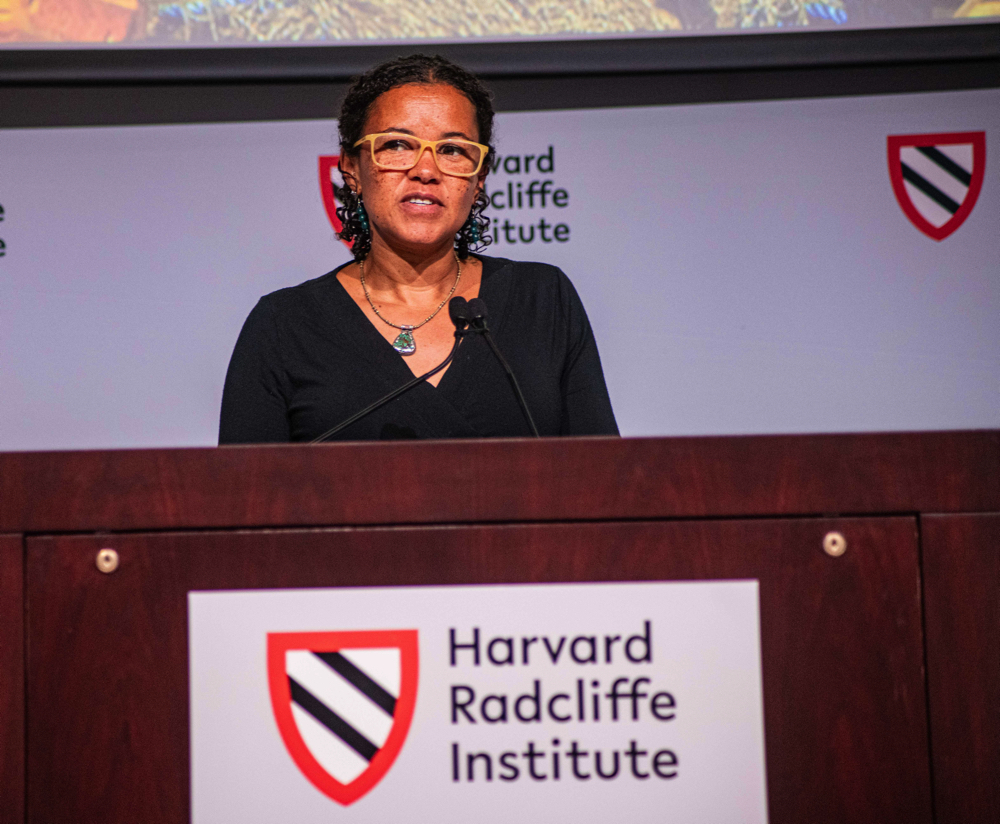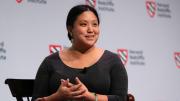Thirty-five percent of food produced in the United States is never eaten; households are the largest producers of food waste; and the amount of energy it takes to prepare and dispose of U.S. food waste is equivalent to the annual CO2 emissions of 42 coal-fired power plants. Against this backdrop, the Harvard Radcliffe Institute launched its annual science symposium, this year focused on “Feeding the Future: Food Sustainability and Climate Change.” The event began on October 2 with strategies for reducing food waste at home. The following day, panelists from around the globe addressed specific aspects of the world’s food systems in three separate discussions, considering production and transportation, preparation and consumption, and access and security.
The global food system, the audience learned, is responsible for as much as one-third of the carbon dioxide emissions that drive climate change. Food production is, in turn, threatened by storms, droughts, floods and wildfires, whose intensity and frequency are increasing with a changing climate. What can be done to reduce emissions from the food sector? Can the planet feed a growing human population in an altered climate?
Professor of astronomy Edo Berger, director of the Institute’s science program, addressed these questions in his introduction. Food production, he noted, is “an industrial complex, on the one hand, and the livelihood of small family farms on the other. It is transported halfway around the world to satisfy the desires of some, but it’s not stably accessible for at least 10 percent of the world’s population, [the] more than 800 million people who suffer from hunger or food insecurity. And it is a significant stressor even in places like Massachusetts, where 21 percent of households with children are food insecure. And these numbers are much more dire in the Global South and for marginalized communities in the United States.”
A Focus on Food Waste
The first day’s keynote speaker, Boston restaurateur Irene Shiang Li, discussed actions that anyone can take to address the problem of food waste. Li, who won the 2022 James Beard Leadership Award for “visionaries responsible for creating a healthier, safer, and more equitable, and sustainable food system,” is coauthor of the cookbook Perfectly Good Food: A Totally Achievable Zero Waste Approach to Home Cooking (W. W. Norton, 2023). She shared some of the “hero recipes” that she uses at home to rescue foods in the fridge that “we’re not quite sure how they got there, or how they’re going to leave.” Among the strategies: making pesto from local greens, not just basil; using eggs and cheese to make frittatas that deliciously enfold all kinds of orphan ingredients, even pasta; and keeping an “eat me first” box at the front of the refrigerator. Frozen puff pastries are another “secret weapon” she keeps on hand. “Because you can take your leftovers,” serve them in a pastry, “and then they’re French.” She called her book a “toolkit” of ideas for reducing food waste. “But are we expecting everyone to do all our techniques all the time? Absolutely not,” Li said. “We don’t even do that.”
Household food waste, Li pointed out, is costliest because it is the last possible step in the food chain: “A bag of spinach becomes more resource intensive as it makes its way to your home” in terms of transportation, refrigeration, and packaging. “The greatest waste is when we let the food make it all the way to our houses, and then it ends up in the trash or the compost.”
Li didn’t write the book to fight climate change, she added. She and her sister “just wrote it to make cooking feel more accessible and fun. And we expect a lot of people, honestly, to open up the book and have no interest in climate change. They want to save money, they want to get food on the table faster, it just feels bad to throw stuff out—all of those are great reasons…to be thinking about food waste.” Her hope, though, is that reading the book might spark people’s interest in food waste’s effect on the climate. “But…there are a lot of entry points into the topic.”
Production and Transportation
The next day’s first panel discussed how food is produced and transported. Political scientist Sparsa Saha served as moderator; a lecturer in Harvard’s government department, she teaches the food systems and politics course, “The Great Food Transformation.” Biotechnologist Diane M. Beckles, a professor in plant sciences at the University of California, Davis, began by describing her work editing plant genomes. All food crops today, she pointed out, are the result of thousands of years of genetic selection by humans, but with the advent of inexpensive genome editing techniques, people don’t have to rely on random mutations to improve the traits humans value. The focus of her lab is the potato. “We may only need to tweak one out of the 3 billion [base pairs in the potato genome] to get a change that is desirable,” she explained, in order “to engineer crops for longer shelf life, better nutrition, sustainability,” and other traits consumers prefer. At the moment, she is focused on genetic changes that will lower the starchy tuber’s high glycemic index—the potato’s tendency to rapidly convert to sugar when eaten—by increasing fiber content.

Mengyu Li, a postdoctoral fellow at the University of Sydney, Australia, who conducts integrated sustainability analysis, spoke about her efforts to quantify the emissions impact of transporting food. With a metric termed “food mileage,” she has developed a tool that captures the impact of the global food trade network, integrating consumption as well as the upstream supply chain. The work has revealed that the urban footprint of world food miles represents about 13 to 20 percent of total food system emissions. Wealthy regions, such as Europe, North America, and Oceania contribute the most per capita to such emissions. But interestingly, her model has also shown that, in a hypothetical scenario in which all of the food supply is produced and consumed domestically, the emissions reduction is only about 10 percent. The reason, she said, is that this kind of switch would result in substituting low-emission international marine transport of food for high emission distribution by truck: “eating local” is not enough. A real impact will have to engage actors at every stage of the supply chain: wholesalers and retailers, investors, governments, and the U.S. consumer. “In other words,” she said, “we all need to be part of the solution.” That includes transitioning to more plant-based foods, which embody lesser environmental impacts than meat consumption.
David Hughes, Huck chair in global food security at Penn State College of Agricultural Sciences, discussed his work using new technologies to assist farmers in the developing world. He asked the audience to imagine a country where “the average life expectancy is 40 years old, where child mortality is roughly one in three, where less than five percent of people have access to indoor plumbing” and half of income goes to food. This country, he then revealed, was the United States in 1855. And it was in this context that Penn State began as a land grant, or farmer’s, school in 1862. The expertise developed in these institutions in the nineteenth and twentieth centuries is valuable and can be exported to developing countries with agriculturally based economies. It is the kind of expertise that will be needed to “feed 10 billion people in a world that is 2.6 degrees Celsius above historical norms.”

Africa, where “millions of predominantly older women continue to engage in subsistence agriculture,” has been “left behind,” he continued, a sharp contrast to “the impressiveness of mechanization in North America, and the high productivity gains we can have in our system.” Using cellphones and AI, a USAID-funded project he directs called PlantVillage transmits images taken by local farmers to scientists, who then remotely identify crop pests and diseases, as well as the measures for controlling them. Hughes says he hopes the effort can move beyond plant pathology to prophylactic steps that improve plant health, whether through crop diversification, probiotics in the soil, or other measures—but adds that government support for such efforts needs to be expanded.
Saha, noting that the climate crisis “can feel overwhelming,” asked participants, “What gives you hope that we can rise to meet the food challenges of the twenty-first century?” The response from panelist Mengyu Li was startling. “To me, personally,” she said, “I don’t have hope.” Technological improvements take time, she pointed out, and “climate change is so urgent…We have no time. So that’s actually what I’m struggling [with] every day when I do research. And it looks like I have helped. But actually, I really doubt that.” Hughes responded to Li directly, saying “it’s depressing to hear that a young, intelligent scholar like you doesn’t have hope. But,” he continued, addressing the audience, “I would look at her research and body of work to say that she is giving the keys to the kingdom: if you can understand the supply chains, and how much it costs to move things from South America to China, then you can use that for disruption.” He cited how the scarcity and exorbitant cost of hotel rooms in San Francisco had led to the creation of AirBnB, a new model for lodging, and quoted Margaret Mead, who said, “Never doubt that a small group of thoughtful, committed citizens can change the world; indeed, it’s the only thing that ever has.”
Preparation and Consumption
The food shortage projections attributable to climate change are sobering, as Meredith T. Niles, an associate professor and associate director of the Food Systems Research Center at the University of Vermont, explained. The International Food Policy Research Institute estimates that, by 2050, 25 percent more people will be at risk of hunger than without climate change: an additional 38 million people, she said during a panel discussion on food preparation and consumption, moderated by Frank Hu, Stare professor of nutrition and epidemiology, professor of medicine, and chair of the department of nutrition at Harvard’s Chan School of Public Health. “The most food insecure places,” Sub Saharan Africa and Asia in particular, “are also those at highest risk of future climate vulnerabilities.”
Niles outlined a variety of impacts. Climate change will:
- Lower crop yields in most areas, particularly in rice-producing regions where that crop is a staple of the diet, and possibly lower its nutrient content.
- Threaten the viability of seafood and fisheries ;
- Increase the virulence of pest weeds and pathogens;
- Increase food insecurity among farmers who suffer climate change-linked weather events that damage or destroy crops
- Raise food prices by twice the amount that would have been expected
- Exacerbate water scarcity, which has already led to climate-induced migration
These problems are not confined to the developing world, she clarified, citing an example from her home state of Vermont. The five-foot floodwaters that drowned downtown Burlington this past summer led to huge agricultural losses. “Anytime floodwaters touch agricultural production in the United States…those crops can no longer be harvested.” Farmers in Vermont right now “are trying to figure out how to feed their cows in the fall and the winter” after losing their entire corn crop.
Speaking remotely from Thailand, chef and restaurateur Duangporn “Bo” Songvisava emphasized the importance of food education. “We know the impact of our food choices,” she said, but “we need to have that education everywhere in the world”—ideally “at a really young age….Because if we understand the impact of our food choices—what we put in our mouth, how it impacts our health, how it impacts other people’s health, and also how it impacts environmental health”—that will lead to better choices. Songvisava runs a zero-waste restaurant in Thailand, repurposing ingredients whenever possible, and redirecting other scraps to animals: seafood to chicken farmers, and leftover coconut meat to pig farmers (fermented, it is a valuable probiotic in the pigs’ diet). She works with a local glassblower to turn their empty supply bottles into beautiful jugs. Spent oil is turned into soap.
Can changing U.S. dietary guidelines be part of the solution? Eve Stoody, lead nutritionist at the Center for Nutrition Policy in the Food and Nutrition Service of the U.S. Department of Agriculture (USDA), noted that new guidelines have been released every five years since 1980, and the next edition, already well underway, will be released in 2025. The guidelines, she said, have traditionally focused on “meeting nutrient needs promoting human health and preventing diet-related chronic diseases.” The topic of sustainability was first mentioned in the 2010 guidelines, with expanded treatment in the 2015 edition, which found that shifting American consumption to a healthier pattern would also lead to environmental benefits. She added that “there are a lot of activities within USDA and HHS [Health and Human Services] related to food sustainability and climate change.” One is a National Institutes of Health project called ADVANTAGE (Agriculture and Diet: Value Added for Nutrition, Translation, and Adaptation in a Global Ecology), which is “looking at the intersection of food systems, diet, nutrition and health and a changing environment.” Another federal workgroup, just formed, is studying ways to integrate sustainability into future editions of the dietary guidelines.
Niles emphasized that, in order to create sustainable distribution and supply chains that support growing a healthy diversity of foods in a given place, a systems approach to the issues is critical. “I think the dietary guidelines are a really interesting example,” she said. “We have two federal agencies that work on something jointly related to nutrition. We could think about something like that happening in a food systems context, where we would bring together not just HHS and USDA, but so many other federal agencies like transportation,” which also “should be thinking about food systems and food transportation.”
Beyond Food Access and Security
The symposium’s final panel focused on the most tragic aspect of food system failures: that even where there is plenty, many people don’t have enough to eat. Christina Hicks, a professor at Lancaster University’s Environment Centre, is an environmental social scientist who studies the interaction between people and ecosystems. She is particularly interested in small scale fisheries, which account for almost half of global catches. Most of them are in Asia, Africa, and Oceania, where diets are predominantly plant-based, and fish, as the only source of animal food, provides key micronutrients. Her research has shown that, while catches plateaued beginning in the 1990s, “fisheries-derived nutrients are now just as high as they have ever been since records began. And we know that per capita fish consumption also has doubled.” But although enough fish are being caught, “often in the places where they’re needed most,” they are not reaching the populations that need them. Local availability, she said, is not translating to access.

To understand why, she and two colleagues traveled to Senegal, where fish, she reported, “makes up to 80 percent of the animal-source food in an otherwise plant-based diet.” Traditionally, the small pelagic fish caught there were considered too bony to interest the developed world as a food. But in the past decade, Hicks said, “West Africa has seen a dramatic increase in the export of fish meal” as more than 40 industrial processing plants have been built along the coast. “And this has been associated with a decline in the consumption of fish.” In Senegal, for example, the consumption of fish has halved. The processing plants, with access to a global market, can afford to buy the fish from the fishermen at a higher price than the women traders who have traditionally bought them for food.
Global patterns of foreign fishing have also been moving nutrients towards food secure regions, and away from places with unmet nutrient needs. “A significant amount of fish,” she said, “is being moved before it even reaches land.” Last year, the World Trade Organization made an agreement to phase out fishery subsidies, which drive both overfishing and distant water fishing. But the current agreement is nowhere near ambitious enough, Hicks said, because it still allows too many of these practices to continue. To achieve goals such as decarbonization and sustainable fisheries, she argued, the distal drivers of nutrient inequity will need to be brought into “the fisheries governance and management equation.”
The idea that abundance is inadequate as a measure of food security was a theme continued by M. Jahi Johnson-Chappell, a professor of civil and environmental engineering in the Tufts University School of Engineering and of water diplomacy in the Fletcher School of Law and Diplomacy. Looking at the reduction in child undernutrition during the past 40 years, social scientists have found that higher crop yields are not the most important factor. Dietary diversity, or percent of energy derived from non-staple foods, has been a critical lever. But 25 percent of the reduction, Johnson-Chappell said, is attributed to access to safe water, and 22 percent to female secondary school enrollment, followed by per capita energy supply. Food security, he stressed, involves much more than rising crop yields.
He also pointed to some very difficult findings from multinational accounting organization KPMG, which measured the environmental costs of food systems that are not currently reflected in prices. Those uncaptured costs represent 222 percent of food industry earnings. In other words, food producers “would have no profits left if they had to pay the full cost of the externalities and took no mitigating actions.”
“If we just said we’re doubling the price of food,” Johnson-Chappell said, “that would cause a lot of catastrophic changes. Nonetheless, what we’ve done presently, too often, is just ignore it. And that is completely infeasible. We need to address it head on, even if the answer is not necessarily easily at hand, and [higher] yields” are not going to solve the problem.
Shafiqul Islam, also a professor of civil and environmental engineering in the Tufts University School of Engineering and of water diplomacy in the Fletcher School of Law and Diplomacy, said that the question of how to feed people in the future is problematic, given that 800 million people globally do not have food on a daily basis right now. In Boston, for example, the homeless and hungry could easily be fed with uneaten food prepared in local restaurants—except that liability concerns prevent that. Extrapolating to food abundance at the global scale, “No established methodology exists for this type of complex problem,” he said. “Once we identify that the problem is rooted in the way society is structured, if society cannot come to a consensus, then doing lots of science is not going to work.” Echoing the calls from many of the day’s speakers for widespread civic involvement and improved governance, Islam said that “choosing what path to follow is subjective. And that has to be done by negotiation, and by stakeholder participation, and by bringing everybody on board.”









